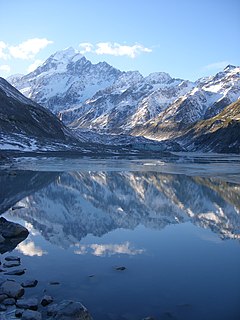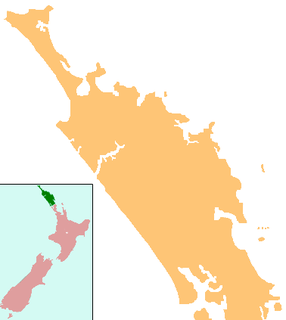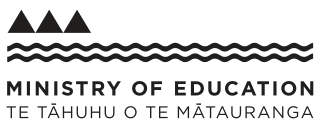
Aoraki / Mount Cook is the highest mountain in New Zealand. Its height since 2014 is listed as 3,724 metres, down from 3,764 m (12,349 ft) before December 1991, due to a rockslide and subsequent erosion. It lies in the Southern Alps, the mountain range which runs the length of the South Island. A popular tourist destination, it is also a favourite challenge for mountain climbers. Aoraki / Mount Cook consists of three summits, from South to North the Low Peak, Middle Peak and High Peak. The summits lie slightly south and east of the main divide of the Southern Alps, with the Tasman Glacier to the east and the Hooker Glacier to the southwest.

Kiwi is the nickname used internationally for people from New Zealand, as well as being a relatively common self-reference. Unlike many demographic labels, its usage is not considered offensive; rather, it is generally viewed as a symbol of pride and endearment for the people of New Zealand. The name derives from the kiwi, a native flightless bird, which is a national symbol of New Zealand. Until the First World War, the kiwi represented the country and not the people; however, by 1917, New Zealanders were also being called "Kiwis", supplanting other nicknames.
Secondary education in New Zealand takes up to five years, covering the ages 13 to 18, corresponding to the school years 9 to 13.

Te Aute College is a school in the Hawke's Bay region of New Zealand. It opened in 1854 with twelve pupils under Samuel Williams, an Anglican missionary, and nephew and son-in-law of Bishop William Williams. It has a strong Māori character.

Greytown, population 2,202, is a rural town in the heart of the Wairarapa region of New Zealand, in the lower North Island. It is 80 km north-east of Wellington and 25 kilometres southwest of Masterton, on State Highway 2. It was awarded the title of New Zealand's Most Beautiful Small Town 2017.

Mount Hikurangi is a 1,752 m (5,748 ft) peak in the eastern corner of New Zealand's North Island, about 80 kilometres (50 mi) north of Gisborne, and 50 kilometres (31 mi) southwest of the East Cape Lighthouse. On a spur of the Raukumura Range in the Waiapu Valley, it is the North Island's highest non-volcanic peak.

The Minister for Māori Development is the minister of the New Zealand government with broad responsibility for government policy towards Māori, the first inhabitants of New Zealand. The Minister heads the Te Puni Kōkiri. Between 1947 and 2014 the position was called Minister of Māori Affairs; before that it was known as Minister of Native Affairs. As of 2017, The current Minister for Māori Development is Nanaia Mahuta.

Kamo is a small township north of Whangarei, approximately five minutes drive from the Whangarei CBD. The name is a Māori word meaning "eyelash", but has also been said to mean "to bubble up", referring to hot springs in the area. Mount Parakiore is a volcanic dome rising 391 m to the northwest of the town. It is about one million years old, and part of the Harbour Fault which also includes Mount Hikurangi near Hikurangi, and Parihaka in Whangarei.

The Government of New Zealand, or New Zealand Government, is the administrative complex through which authority is exercised in New Zealand. As in most parliamentary democracies, the term "Government" refers chiefly to the executive branch, and more specifically to the collective ministry directing the executive. Based on the principle of responsible government, it operates within the framework that "the Queen reigns, but the government rules, so long as it has the support of the House of Representatives".

Whangape Harbour is a harbour on the west coast of Northland, New Zealand. There is a settlement called Whangape or Whangapē on the northern side of the harbour. Another, called Pawarenga, is located on the southern side. Kaitaia is 42 km north east.

Whangaroa Harbour, previously spelled Wangaroa Harbour, is an inlet on the northern coast of Northland, New Zealand. Whangaroa Bay and the Pacific Ocean are to the north. The small settlements of Totara North and Saies are on the west side of the harbour, Waitaruke on the south side, and Whangaroa on the east. State Highway 10 runs through Waitaruke. The name comes from the lament "Whaingaroa" or "what a long wait" of a woman whose warrior husband had left for a foray to the south. The harbour was formed when rising sea levels drowned a river valley about 6,000 years ago. Steep outcrops remain from ancient volcanic rocks.
The law of New Zealand can be found in several sources. The primary sources of New Zealand law are statutes enacted by the New Zealand Parliament and decisions of the Courts of New Zealand. At a more fundamental level, the law of New Zealand is based on three related principles: parliamentary sovereignty; the rule of law; and the separation of powers. As a former British colony, the New Zealand legal system is heavily based on the English law, and remains similar in many respects. There are also important differences, which reflect the unique legal culture that has developed in New Zealand.
Te Puni Kōkiri (TPK), the Ministry of Māori Development, is the public service department charged with advising the government on policies and issues affecting the Māori community; promoting Māori achievement in health, training and employment, education and economic development; and monitoring the provision of government services to Māori. The name means "a group moving forward together".

Tikitiki is a small town in Waiapu Valley on the north bank of the Waiapu River in the Gisborne Region of the North Island of New Zealand. The area in which the town resides was formerly known as Kahukura. By road, Tikitiki is 145 km (90 mi) north-northeast of Gisborne, 20 km (12 mi) northeast by north of Ruatoria, and 24 km (15 mi) south by east of Te Araroa. The name of the town comes from the full name of Māui, Māui-tikitiki-a-Taranga. State Highway 35 passes through the town at the easternmost point of the New Zealand state highway network.
In New Zealand, a state-integrated school is a former private school which has integrated into the state education system under the Private Schools Conditional Integration Act 1975, becoming a state school while retaining its special character. State-integrated schools were established by the Third Labour Government in the early 1970s as a response to the near-collapse of the country's then private Catholic school system, which had run into financial difficulties.
Hukarere Girls' College is a girls secondary boarding school in the Hawke's Bay region of New Zealand. It has a strong Māori character and follows the Anglican tradition. The School motto "Kia Ū Ki Te Pai" means "Cleave to that which is good" or "Abhor that which is evil".












